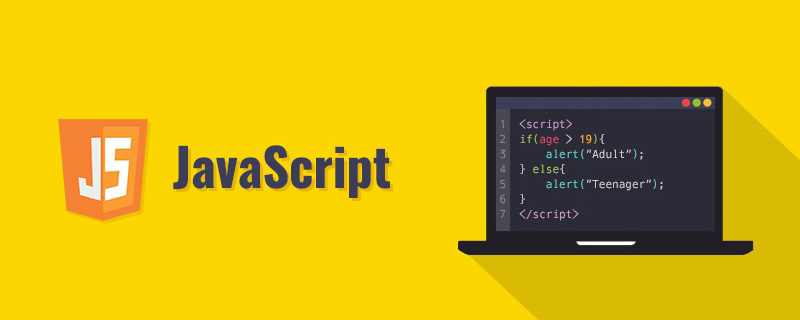Home >Web Front-end >JS Tutorial >Summary of declaration and naming conventions of javascript variables
Summary of declaration and naming conventions of javascript variables
- WBOYWBOYWBOYWBOYWBOYWBOYWBOYWBOYWBOYWBOYWBOYWBOYWBOriginal
- 2022-08-03 17:17:012448browse
This article brings you relevant knowledge about javascript, which mainly introduces JavaScript writing rules, variable declaration format, variable naming rules, and precautions, and variable data types , the classification of data types, the usage of null (null) and undefined (undefined), let’s take a look at it together, I hope it will be helpful to everyone.

[Related recommendations: javascript video tutorial, web front-end】
Grammar rules
JavaScript is not sensitive to newlines, indentations, and spaces.
A semicolon must be added at the end of each statement. Although the semicolon is not necessary, in order to compress the program in the future, if the semicolon is not added, it will not run after compression.
All symbols are in English. Such as brackets, quotation marks, and semicolons.
Comments
Adding comments to the program can facilitate understanding and explain the function of the program, and enhance the readability of the code. The program will not run with the comment content.
Variable declaration syntax format
Declaring variables is done using the system keyword var. Variables can be declared individually or multiple at the same time. When declaring, You can initialize variables (variable character values)
Example:
var name; //声明一个变量 var name, sex, age; //同时声明多个变量,多个变量间用英文下的逗号隔开 var name = "小强"; //一边声明一边赋值
Declaration of variables (three ways)
Variables need to be declared before use ;The keyword for declaring a variable is: var;
语法:var 变量名 = 变量值;
Declare first, then assign a value
var a; //变量的声明 a = 10; //变量的赋值
Declare and assign a value at the same time
var a = 10; //变量的声明和赋值
Declare multiple variables at the same time and assign a value (Note: When declaring multiple variables and assigning values, separate the variables with commas)
var a = 10, b = 20; //多个变量的声明和赋值
Do not declare, assign directly (note: this is an irregular way of writing!)
age = 18; //变量的赋值 console.log( age ); //结果为20,浏览器能帮助识别,但是不规范,不推荐使用
Only declare, No value assignment, the default is undefined
var name; //变量的声明 console.log( name ); //undefined
Do not declare or assign a value, use it directly
If a variable is neither declared nor assigned a value, use it directly, an error will be reported, name is not defined, Because this name variable does not exist at all. Note: Starting from the line where the error is reported, the subsequent code will not be executed!
console.log( '我是第一行代码' ); //正常显示 console.log( name ); //报错 console.log( '我是第二行代码' ); //不显示不执行
Variable naming rules
Strictly case-sensitive (uppercase variables and lowercase variables are different variables)
-
Variable names cannot start with numbers, but can start with letters, underscores or $
For example: var _name, $age;(correct) var 3abc;(wrong)
-
Variable names cannot be system keywords.
For example: var, switch, for, case, else, while, etc.
-
Variable names in JS are case-sensitive.
For example: name and Name are two variables
-
The names of variables in JS must be meaningful.
For example: the variable representing age uses age, and the name uses userName
-
Two naming methods when the variable name consists of multiple words
-
Camel case naming:
The first word is all lowercase, and the first letter of each subsequent word is capitalized.
For example:
var userName = "钢蛋"
-
Underline naming:
All words are lowercase, connected with underscores
For example:
var get_user_name = "铁柱"
-
The data type of variables
Variables have data types. JavaScript is a weakly typed or dynamic language, which means there is no need to advance Declare the type of the variable. When the code is running, the data type of the variable is judged by the JS engine based on the data type of the variable value on the right side of the variable = (equal sign). It also means that the same variable can be used as different types. This type comes from the "value of the variable"
In other words: what type the value is, what type the variable is.
-
The types of variables in JS are:
Numeric type (number), character type (string), Boolean type (boolean), undefined (undefined), null (empty), array (array), object (object), function (function)
The data types of variables are divided into two categories
Basic data types:
Numeric type, character type, Boolean type, undefined type, empty type. Very notable feature: a variable name can only store one value.
var a = 10; var b = 'string'; var c = false; var d = undefined; var e = null;
Composite data type
Arrays, objects, functions, notable features: a variable name may store multiple values.
var arr = [10,20,30,40];//数组
var today = new Date();//对象
//函数
function myFunction(){
console.log('函数');
}
Numeric type: Variables that can perform mathematical operations
Numeric types include: integer, floating point, NaN (indicating that it is not a numerical value).
var a = 999;// 整型 var b = 0.9;// 浮点型 var c = NaN;// NaN
A very special value NaN in the numerical type, NaN (not a number) is not a number; when converting other data types into numerical types, the conversion cannot be done, but the program cannot report an error. At this time Will return a NaN value; NaN itself is a Number variable.
Character type
A string enclosed in single quotes or double quotes.
var a = "我是一个字符串"; var b = '我也是一个字符串'; var c = "";
Note:
- 单引号和双引号之间可以相互嵌套;
- 单引号内只能嵌套双引号;
- 双引号内只能嵌套单引号。
布尔型
布尔型又称逻辑型。只有两个值:true(真)、false(假)。
布尔型只有两个状态。如:性别、婚否、灯的开关等。
布尔型常用if条件判断语句中
var a = true; var b = false;
未定义型 undefined
当一个变量定义,但未赋值时,将返回未定义型,未定义型的值只有一个undefined。
当一个对象的属性不存在,也返回未定义型。
var a;//定义了变量但未赋值
console.log(a) // undefined
// 定义了一个对象
var obj = {
uname: '品如',
info: '你好骚啊!',
age: 20
}
var test = obj.gender
console.log(test) // undefined
空型 null
当一个对象不存在时,将返回空型,空型的值只有一个null。
也可以理解为:是一个对象的占位符。
如果想清除一个变量的值的话,可以给赋一个null的值。
var a = 100; var a = null ; //将一个null赋给一个变量,用于清除它的值
【相关推荐:javascript视频教程、web前端】
The above is the detailed content of Summary of declaration and naming conventions of javascript variables. For more information, please follow other related articles on the PHP Chinese website!

